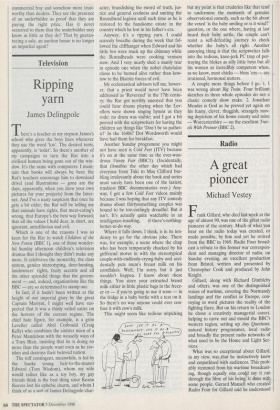Salerooms
A salutary lesson
Susan Moore
The most valuable and most impor- tant single-owner collection of European furniture ever seen at auction' was offered at Christie's New York last week. The 60 or so 'museum-quality masterpieces' of French and English furniture, along with another two dozen lots of Chinese porce- lain, ormolu clocks, candlesticks and can- delabra and the like, were expected to fetch a spectacular $30 million-$40 million. Christie's, so some sources have it, secured the consignment by offering a guarantee a proportion of the estimated total whether or not the objects sell — some 30 per cent higher than that offered by rivals Sotheby's. These guaranteed sums are always confi- dential but, calculating on the basis of the common deal of 80 per cent of the low esti- mate, the figure was around $24 million. What did the sale make? Almost precisely half.
No doubt the sale has proved a salutary lesson on the dangers of winning the battle but losing the war. This commercial hiccup has cost the firm dearly; all the understand- ably tight-lipped representative would con- firm was that, yes, the auction house had an 'interest' in the 27 unsold lots. But now, like it or not, such gambles have become just part of the day-to-day business of our brave new world of auctioneering. Far from being an unmitigated disaster, this sale demonstrates more than anything else the phenomenal muscle and extraordinary suc- cess of this new world order.
For, crucially, this so-called collection did not come from some down-at-heel European aristocrat but represented the stock-in-trade of the furniture and objects belonging to French & Co., the oldest and one of the finest antiques dealers in New York. These pieces came to the block because its current owner, former stock- broker and oilman Martin Zimet, is hand- ing over the reins to his son who wishes to concentrate solely on picture dealing. It is hard to imagine that there were many of the world's big players in the field of French or English furniture who had not been offered these pieces already. More- over, some of the most important lots in the sale had been languishing in the firm's inventory for 20 years, some pieces possibly even longer. Take the star lot, a lavishly mounted Louis XV Japanese lacquer commode made around 1744 by the greatest ebeniste of the period, Bernard II Van Risenburgh, who stamped his furniture BVRB. Oddly, and much to the fury of the French trade who let the piece go around 1980, Christie's experts seem to have been the first to bother to examine the back of the piece and notice the stencilled royal inven- tory number 1343, identifying the com- mode as made for the Dauphine's bedroom at Versailles, no less. Interestingly, Christie's tell me that the royal provenance did not affect the estimate of the piece — a mighty $4 million-$6 million, but apparent- ly still less than the shop price — but might well have found it a buyer. (It did not.) It is also worth pointing out that although all of this furniture, English as well as French, was of the grand and showy variety, dripping with gilt-bronze ormolu or elaborately carved or inlaid, few pieces were as ravishing, as happily proportioned, designed or worked as another BVRB piece, a lacquer bureau en pente. (This one actually sold, though on the low estimate, for just over $2 million.) The remarkable feature of this sale was not that two lots the BVRB commode and another sumptu- ously mounted Louis XV piece made by Charles Cressent and with a Rothschild provenance (estimate $3 million-£5 mil- lion) — failed to sell, but that five of the seven lots valued at over $1 million found new homes.
One, a George III ormolu-mounted rose- wood, fruitwood and marquetry bombe commode made by the émigré master Pierre Langlois, became the second most expensive piece of English furniture ever sold at auction. Going for $2.5 million or £1.5 million, it was just short of the record set in 1993 for the Anglesey desk. More- over, a George II mahogany tripod table fetching $343,500 or £208,182 — perhaps not best served by enlarged details of the carving — similarly became the most expensive example of its type sold at auc- tion. Revealingly, all the buyers of the top ten lots were private.
So there you have it: the auction houses, who, unlike the dealers, do not have to invest in merchandise — not often, anyway — can invest instead in marketing and client reassurance. Like a certain branded lager, they reach parts that others cannot. Certainly no dealer can rival their client lists or could afford to accord the BVRB or Langlois commodes 14 pages of a glossy hard-backed catalogue with an appropri- ately long and scholarly text to demon- strate their importance, not to mention illustrations of comparable examples at Windsor Castle to give further reassurance to any potential buyer about what kind of company he was keeping.
What is most fascinating about the whole business of the auction houses' capture of the retail market is how they have managed to convince their clients that buying at auc- tion is somehow safer than buying from the trade, that auctioneers as the mediators between vendors and buyers are above the commercial fray and somehow more trust- worthy than dealers. They see the presence of an underbidder as proof that they are paying the right price. Has it never occurred to them that the underbidder may know as little as they do? That by guaran- teeing a sale, an auction house is no longer an impartial agent?



















































































 Previous page
Previous page